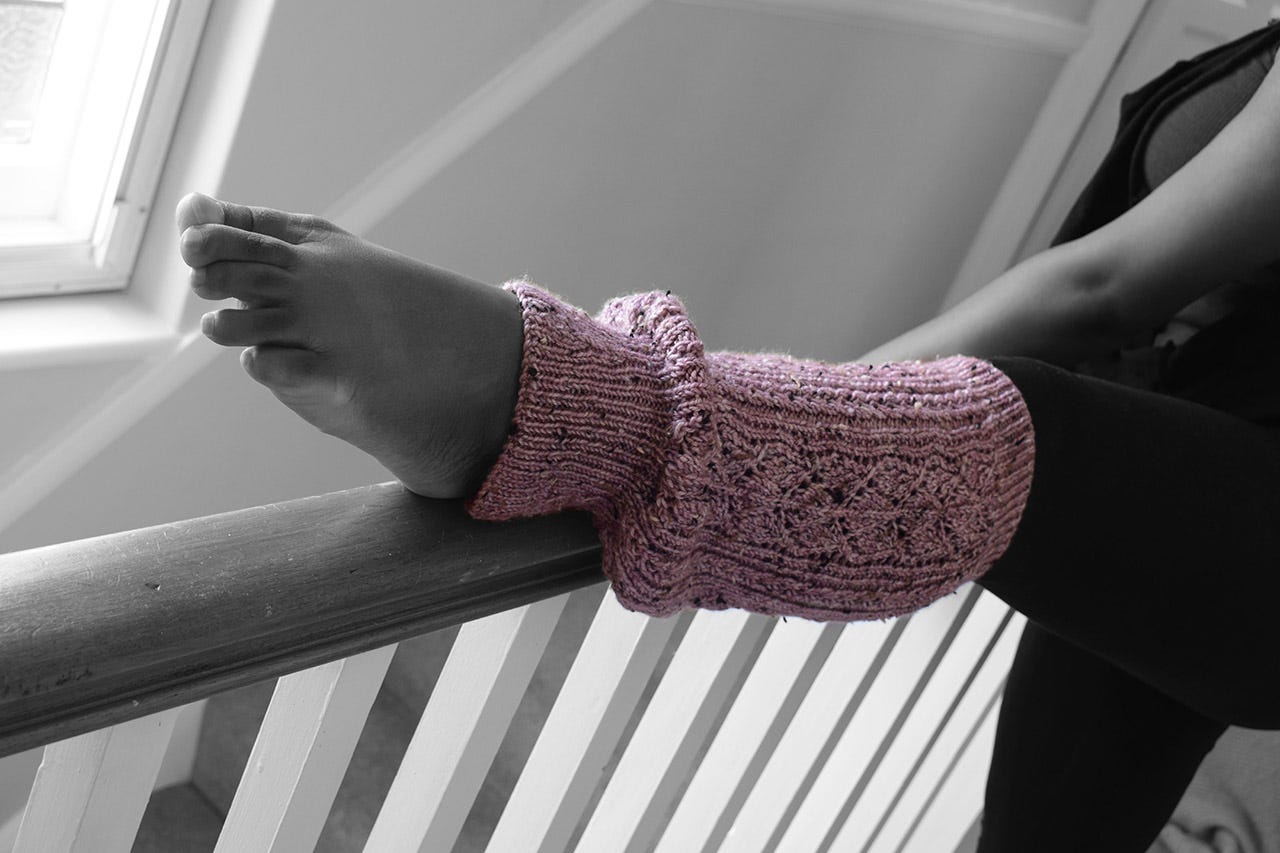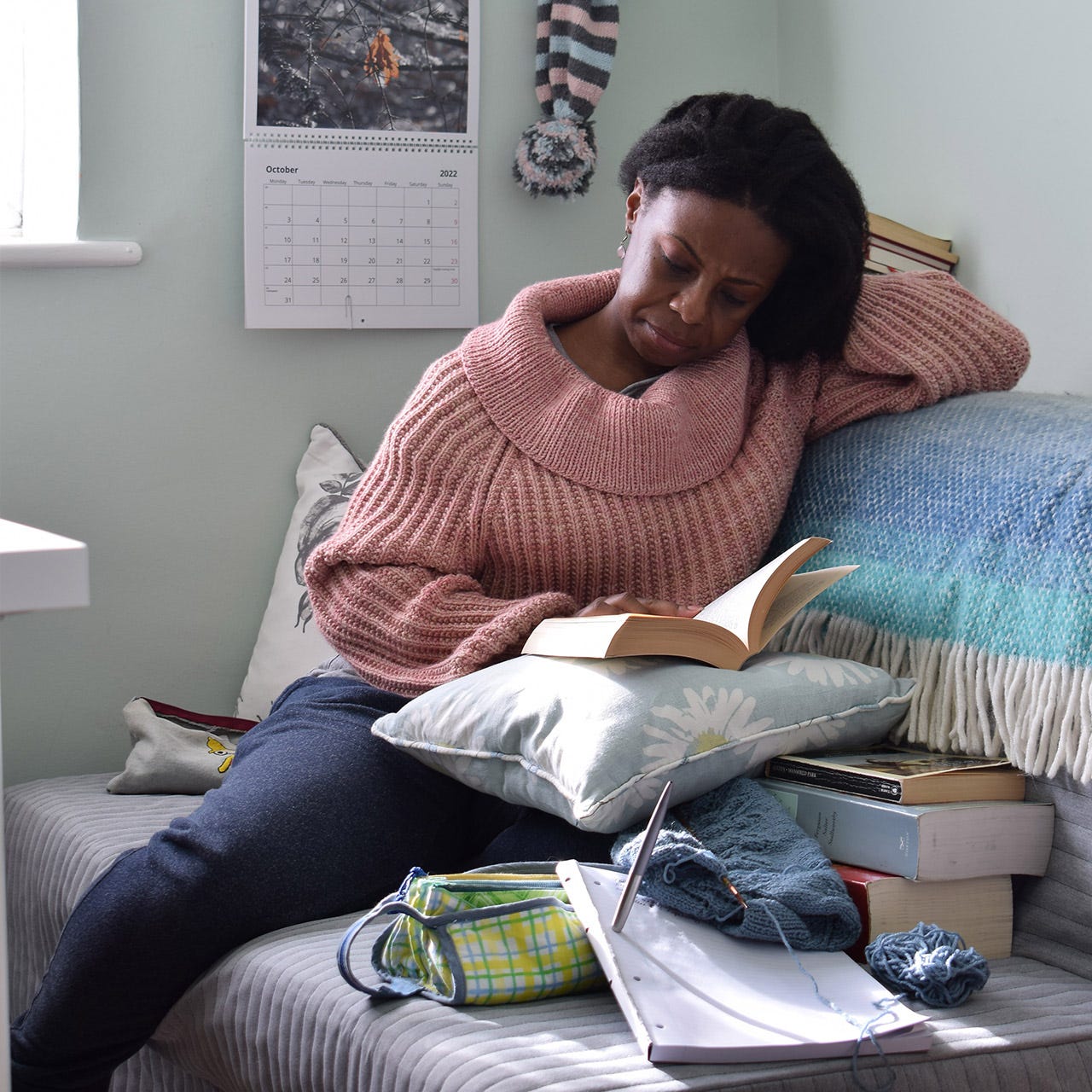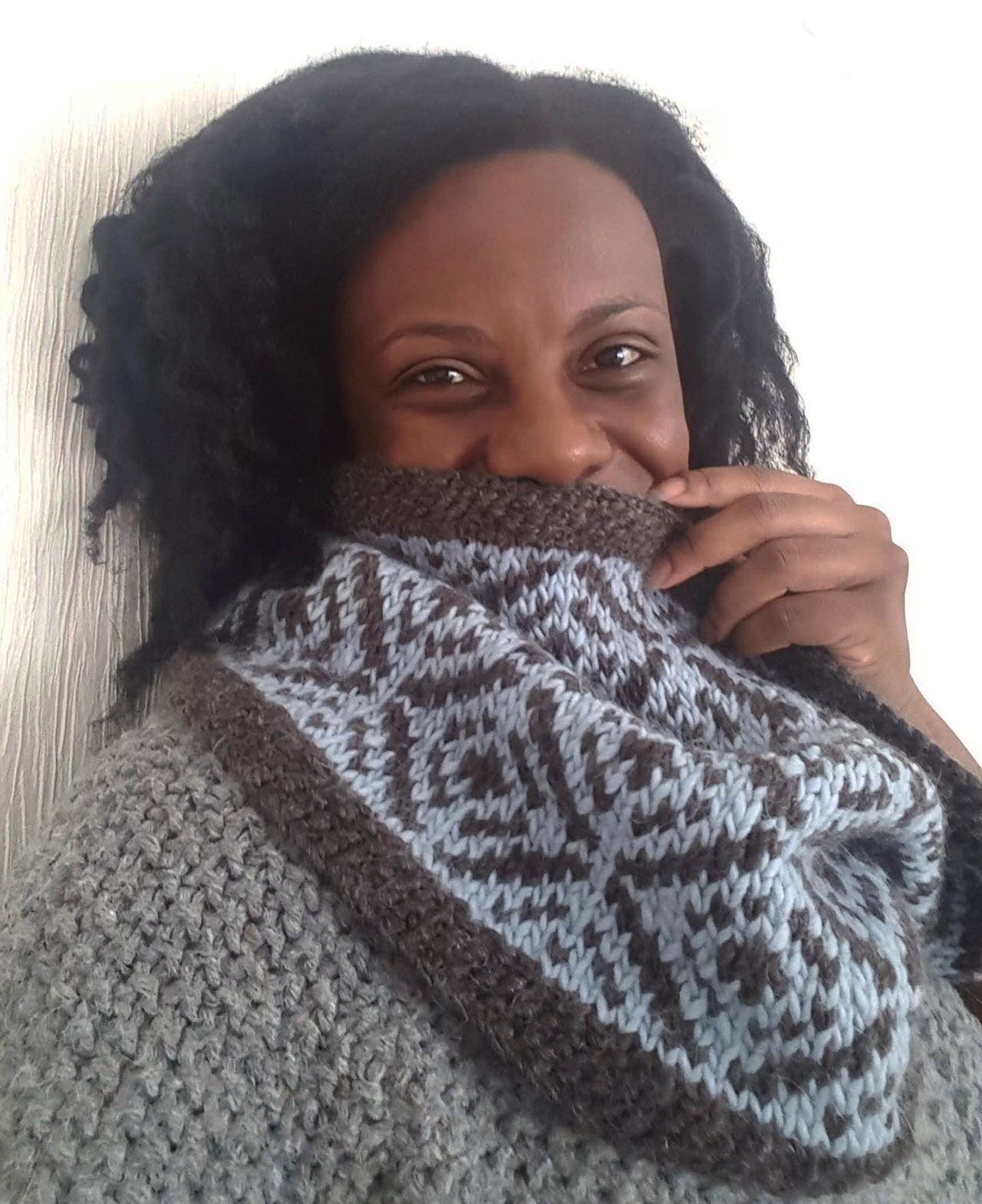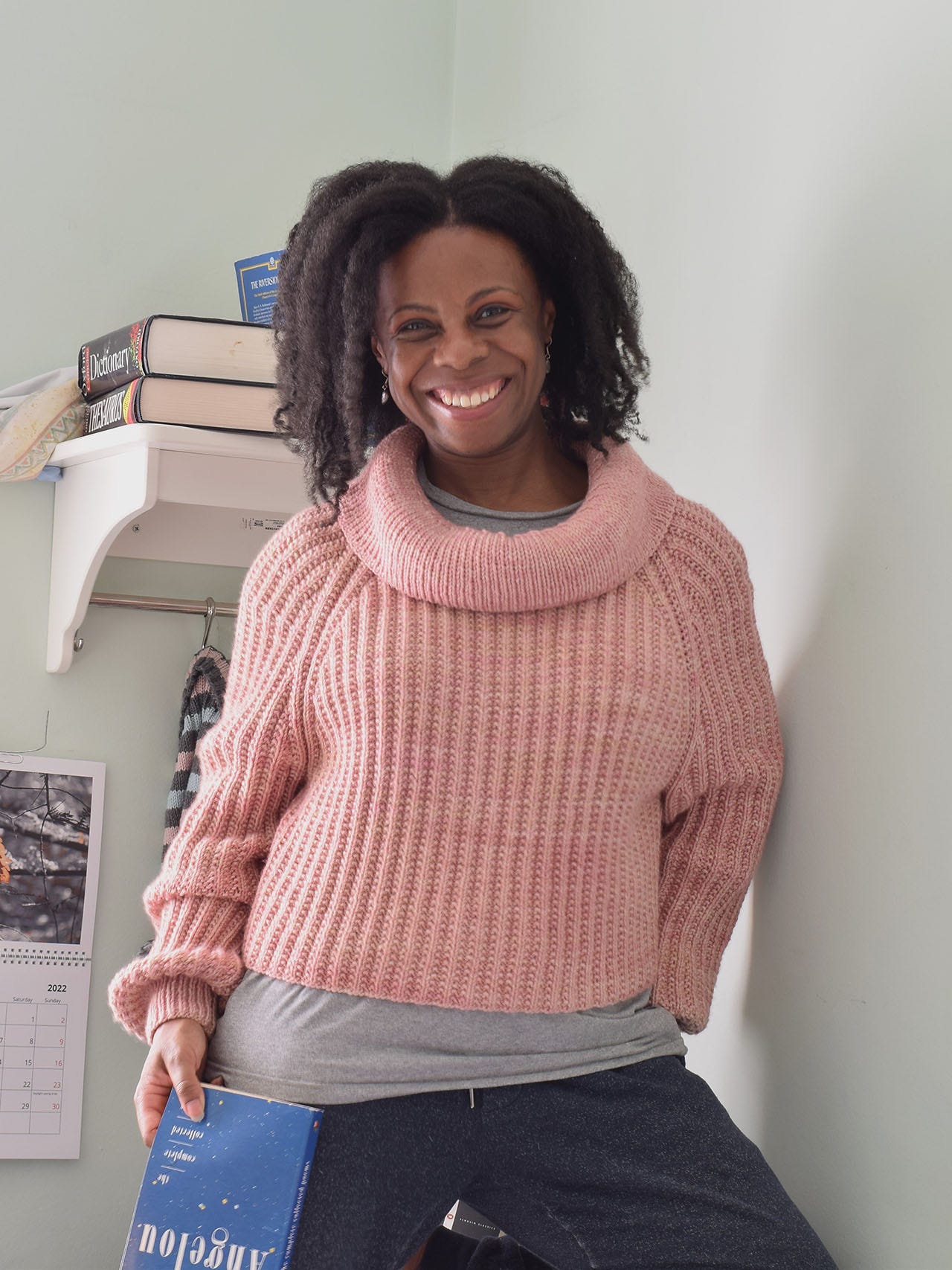How I Create: Natalie Warner, knitwear designer, teacher and writer
Natalie Warner on how her design process has evolved since launching her first collection, bringing more freedom back into her creative work, and creating her pilot knitwear design course.
Natalie Warner is a knitwear designer, teacher and writer who creates original and timeless knitting patterns for sweaters, cardigans and various accessories.
She recently launched her pilot knitwear design course and the first module, which centres around visual communication, sold out within a week. While Natalie is an experienced teacher in higher and further education, this is the first time she has designed this type of course, building a learning community and selling directly to her students. In this interview, Natalie talks about what this process has looked like, and how different it feels to forge this more direct relationship – and wear all the hats – when creating your own offerings.
Natalie also shares how her design process has evolved since launching her first collection in 2013; why the way she creates has changed through tuning into her natural ebbs and flows; and some inspiring words for creatives who can’t see any exemplars of people doing the things they feel called to do.
Can you tell us a bit about your background and story so far. Where did your interest in fashion, crafts and textiles begin, and how did you get into teaching, designing and writing?
It all began at home. My great-grandmother was a sample machinist for Marks and Spencer, and my grand-uncle was a tailor. I grew up watching my mum and grandma knit, embroider and sew; sometimes for pleasure, but mostly for practical reasons. I can remember my mum shopping for remnants at our local department store so that she could make me a dress! My favourite clothes were always the ones that had been made by my family, so I learnt as a small child first by watching, then by helping, and then finally working alone.
I didn’t really think about knitting in a professional way, but that chapter began when knitting turned into a kind of occupational therapy for me. I went through a horrible professional experience whilst working as a research assistant and found solace in lunchtime and after-work trips to Liberty and John Lewis. Both stores had beautifully curated Rowan Yarns concessions. At breaking point knitting was the only thing that brought me joy, and by then – I was 26 – I’d already spent years digging deep into pattern alterations and pattern cutting. I enrolled on a conversion course at the London College of Fashion, and in the following spring, the Liberty staff told me about a part-time vacancy over the road at John Lewis. I applied, took my portfolio to interview, and was offered the position!
I spent three years at Rowan before realising that they weren’t going to nurture me as a designer or teacher, but whilst working for them I’d developed both skills further via in-store teach-ins and taking every opportunity to talk to designers at head office. The year I left, 2013, I started teaching at Sew Over It and, with the encouragement of Sarah Hazell, submitted a few garment designs to the then-editor of Knitting magazine. What is now the Falling Leaves jumper was commissioned, and I haven’t stopped working since! Since 2015 I’ve taught in higher education (HE) and further education (FE), and designs have been produced along the way.
What does your design process look like and what tools and materials do you tend to use for your work?
I’ll start with tools and materials because that’s easier! I can’t do without squared paper; that’s a godsend because tessellation symmetry is all over knitwear. I use a specialist programme called Stitchmastery for generating charts if the pattern needs one, and the other CAD I use is Excel for pattern grading, Adobe Illustrator for spec drawings and Word for copy. I don’t do my layouts, but I’d use InDesign if so.
Process-wise, I can take two routes depending on what’s inspired me: silhouette or pattern. If it’s the former, I’ll focus on style lines, fabrication, volume, scale, ratio – things that make the most of the garment’s shape and the visual relationships I want to convey. Surface pattern is kept relatively simple, but on the other hand, if I lead with pattern, I’ll begin with yarn swatches. I’ll use squared paper again to note down experimentation and progress. If surface pattern rules, ratio, scale and proportion are still important, but I pay closest attention to the rhythm of the pattern; whether it’s easy to memorise, has visual cues, or can be followed intuitively. Garments are amongst the largest or most technical items to make, so I look to reduce stress or friction wherever possible. The overall garment shape is always simple for designs with lots of patterning. There’s lots of annotation at this stage too – if anything important pops into my head, whether about grading or technique, I note it down here.
Once I’ve settled on silhouette and pattern, I can think about final yarn choices and making up the sample. If I have a particular yarn in mind I’ll ask the dyer or spinner for yarn support and it becomes more of a joint project. They promote the final pattern on their side, but I’m responsible for the pattern writing, grading, technical editing, art direction, photography, layouts – plus all the marketing and business-y stuff. It’s a lot to manage, and working with the same editor, photographer and graphic designer is brilliant – we all get each other.
I have two slots for pattern releases: spring and autumn. Anything queued or in the works is held until those times of year; I try to give myself as much time and freedom as possible for design development and realisation.
How did you approach designing your first knitwear collection in 2013, and (how) has your design process evolved since then?
I worked with a lot of freedom back then, for one – and I’m reconnecting to it now. Frosted Flowers was very much a spare time thing; I wasn’t under any pressure, blissfully ignorant of production processes, nobody knew about me – I just worked on the collection as and when it suited me. It was all about exploring my creativity and the romantic vibe I was going for, and it was a blessing because I was emotionally in tune with what I was doing.
When my designs were published in magazines and my work became more professionalised, things changed – and they changed so gradually I didn’t realise how my new habits had disrupted my natural rhythms. Don’t get me wrong; I’ll always, always be glad of and grateful for the recognition that third-party publications brought me. It allowed me to get closer to knitters of my patterns and see how they engaged with my design ideas, and it was a big career break – everyone needs one. But the stress caused by the endless cycle of work, tight deadlines (one month to knit a jumper and write a complete pattern) and feeling at the mercy of someone else’s direction meant that I lost touch with the love of designing. I’d become a machine.
When my designs were published in magazines and my work became more professionalised, things changed – and they changed so gradually I didn’t realise how my new habits had disrupted my natural rhythms.
It wasn’t until my most recent release, the Karin jumper, that I was able to identify the problem. Because Karin is someone I have a personal connection with, I was led by my feelings, and that allowed me to see that I needed to honour my own timings, ebbs and flows. Plus, the production of that pattern was on its own schedule – let’s put it like that – and I realised that I needed to be, too. So I’m freeing myself from seasonal models from now on. It’s a big relief, nobody’s breathing down my neck, so why don’t I embrace that?
Apart from that, my principles as a designer haven’t changed – that is, my styling and wardrobe building philosophy. Making your own clothes is a mindful process, so if there aren’t enough plain or resting rows in a pattern repeat, for example, I chuck it – people need escapism. And I always go for versatility; knitwear is essentially a key layer in our wardrobes, so it has to lend itself to various styling options. My personal way of dressing comes across in the photography, but all my pieces are evergreen. That’s one of my key words.
What does your teaching work look like today, and how do you approach planning your classes and lectures?
At the moment it’s very community-oriented or about continuing professional development (CPD). For community I teach mothers of young children sewing or knitting, sometimes crochet, and that’s mostly about occupational therapy and reclaiming time for themselves away from their beloved but demanding families! The mothers are reconnecting with themselves, and the children are in a creche learning independently, developing social skills, and trusting that mummy will come back. I love this kind of work and wish I could do much more of it, but funding and finding available space is difficult. Parents get very little support, so classes like mine are crucial for wellbeing and personal development.
My other strand of teaching is more specialist and includes garment construction, pattern cutting and knitwear design. This builds on the subjects I taught in HE and FE, but barriers to learning have increased massively over the last decade or so, and access to existing research and knowledge is a privilege it shouldn’t be. Through my blog and one-off classes I’ve found repeatedly that the things I learnt at home and university are not well-known by handknit designers, who are mostly self-taught. There’s absolutely nothing wrong with self-tuition – it’s inevitable as we go through life – but I’ve observed that I can help or make life easier for some designers by sharing what I know. This wanting to help has led me to pilot a deep and no doubt intensive course that I hope will make a positive impact, now and in the future. I’m terrified and excited!
Making your own clothes is a mindful process, so if there aren’t enough plain or resting rows in a pattern repeat, for example, I chuck it – people need escapism. And I always go for versatility; knitwear is essentially a key layer in our wardrobes, so it has to lend itself to various styling options. My personal way of dressing comes across in the photography, but all my pieces are evergreen. That’s one of my key words.
How do you manage your time across the different aspects of your life and business? What does a typical day or week look like for you?
I’m a big one for compartmentalisation, colour-coding and batching. I have set days for doing certain things because my brain needs structure and systems that aren’t too rigid or timetabled. I like themed days. So Monday and Thursdays are dedicated to my business. Mondays are for settling into the week, and I’ve noticed that I tend to do a lot of writing on Thursdays; newsletter, blog, that kind of thing. Tuesdays and Wednesdays are reserved for community teaching – there’s a lot of paperwork around this so I make sure I finish it on either of those two days and switch off from it for the rest of the week.
My brain is very active, even without having these different things to do, so I couldn’t do without my beloved bullet journal. I try not to schedule more than three tasks a day so I can breathe. If I’m feeling overwhelmed, I’ll do a massive brain dump: anything on my mind gets put onto a list, and I keep going until I can’t think of anything else to do or that’s on my mind. Once I’ve done that, I go through the list and colour-code the items according to the context or area of life. This allows me to group things up, get some perspective, and I always feel a sense of relief when I do this. Things feel manageable again.
I leave Friday open in case I get my timings wrong or need wiggle room. If I’m lucky or have got it right, I’ll go for a long walk and take some photographs. If not, I work in the morning only. I need the afternoon to decompress and do another debrief or brain dump to set me up for Monday. Taking the time to do that means that work is less likely to creep into my thoughts over the weekend.
The only thing missing is mindful exercise like Pilates and yoga. This does me the world of good but I’ve been missing my classes (thanks, pandemic!). I prefer in-person classes because it’s a change of scene, but I’m trying to adapt. I like ballet too: the repetition and focus of yoga, Pilates and ballet is one of the few things that shuts my brain up!
What’s the most valuable lesson you’ve learned about your creative process so far?
To tune into my natural rhythms, to be free of any external pressure or involvement until I’m really ready for it. Creating is such a fully lived experience or process; you use your heart, mind, body and spirit to bring ideas to life or materialise designs. If any of those energies are off or depleted for a period of time, you feel stuck or burnt out. Always honour how you feel and what your energy’s like, and do your best to take the pressure off your creative work.
Creating is such a fully lived experience or process; you use your heart, mind, body and spirit to bring ideas to life or materialise designs. If any of those energies are off or depleted for a period of time, you feel stuck or burnt out. Always honour how you feel and what your energy’s like, and do your best to take the pressure off your creative work.
What’s the biggest challenge you’ve faced in building your business? How have you worked through this?
Oof… this is happening right now! I’m right in the thick of it, realising how best I can help people, what they appreciate most about me, and doing something about it. That is, creating a comprehensive course to train knitwear designers. Writing the course has been the easiest part so far; it tapped into an existing skillset and knowledge base, and I’d done enough research to know what knitters needed most. But – I’ve never designed a course without institutional approval or support, nor have I been confronted with selling to the public or being paid directly for my work. It feels VERY different from selling patterns.
It’s the birth or journey into the unknown, and the death of attitudes that I’m sure will boil down to institutionalisation and conformity culture when I look back. I’m piloting the course now and the first module sold out within a week, which was thrilling and shocking – my nervous system is still getting used to it. I’m feeling more comfortable as time goes on, but I’m in completely uncharted territory and navigating it as best I can. There’s so much to take in, but I’m not afraid anymore – just excited and devoted to teaching my wonderful co-pilots.
What are your top tips for someone who wants to go freelance or start their own creative business?
Apart from working with your idiosyncrasies, ebbs and flows, I’d say answer the call. One of the hardest things I’ve had to deal with was not seeing any exemplars or anyone doing what I wanted to do, never mind running a business – then I realised that’s the point. My creative business looks like me, because it IS me – I’ve imagined it and brought it to life. If I’d understood this earlier, I’d have worried or panicked less about whether or not it was viable.
I’m still figuring this out, but I think that the lack of representation, plus the lack of freedom or agency we’ve been accustomed to in life, short-circuits our power more than we realise. The business you build will be as unique as you are, so if you feel called to do something, it’s because you have the answers somewhere inside you – you just need help getting them out. I’ve been drawing strength from this over the last month or so and I think it’s working so far. I’m holding tight and the voice within is getting louder.
One of the hardest things I’ve had to deal with was not seeing any exemplars or anyone doing what I wanted to do, never mind running a business – then I realised that’s the point. My creative business looks like me, because it IS me – I’ve imagined it and brought it to life. If I’d understood this earlier, I’d have worried or panicked less about whether or not it was viable.
What books or other resources have you found most useful for starting/running your business or developing your creative work?
Dent Global’s free resources and scorecards were really helpful – I especially loved the idea of a product ecosystem because it’s imaginative and makes your work accessible. Eli Trier and Ian Brodie are brilliant writers and great for email marketing, and Eli again for understanding the power of community and how much your supporters will lift you up.
I’m not quite ready for Pinterest’s learning curve but Amy LeBlanc’s courses are really good, and Sarah Burk has lots of practical advice. I found them both through Astrid Bracke, whose small business workbooks and resources have been very helpful.
Last, but by no means least, Ray Dodd has made my head explode in the best way possible! Her Real You, Real Money podcast is brilliant and is transforming my thinking.
What’s been your proudest achievement to date?
Without a doubt, launching the pilot course. I’m still getting used to the fact that it’s not in my head anymore, it’s real!
What does this season and the year ahead look like for you and your business?
It’s all about the pilot course and providing as many learning resources as I can. There are six modules planned, and I’ll be working out what the final course will look like based on what I can manage and mostly how the learning experience has been for my precious co-pilots. Designing is very much on the back burner until further notice, but I’ll keep ideas ticking over very quietly and publish them in my own time. Right now, teaching and access to knowledge is my priority. Also, it gives me a chance to remind people that I have a back catalogue of patterns!
And finally, where can we find out more about you and your work?
My home base is my website, natalieinstitches.com – you can sign up for my blog, newsletter, or both. Blog posts are fortnightly and newsletters are weekly depending on which topics you’re interested in. My main social media is Instagram, where I’m natalieinstitches; I also have Pinterest and YouTube, but not much content yet! All in good time.











